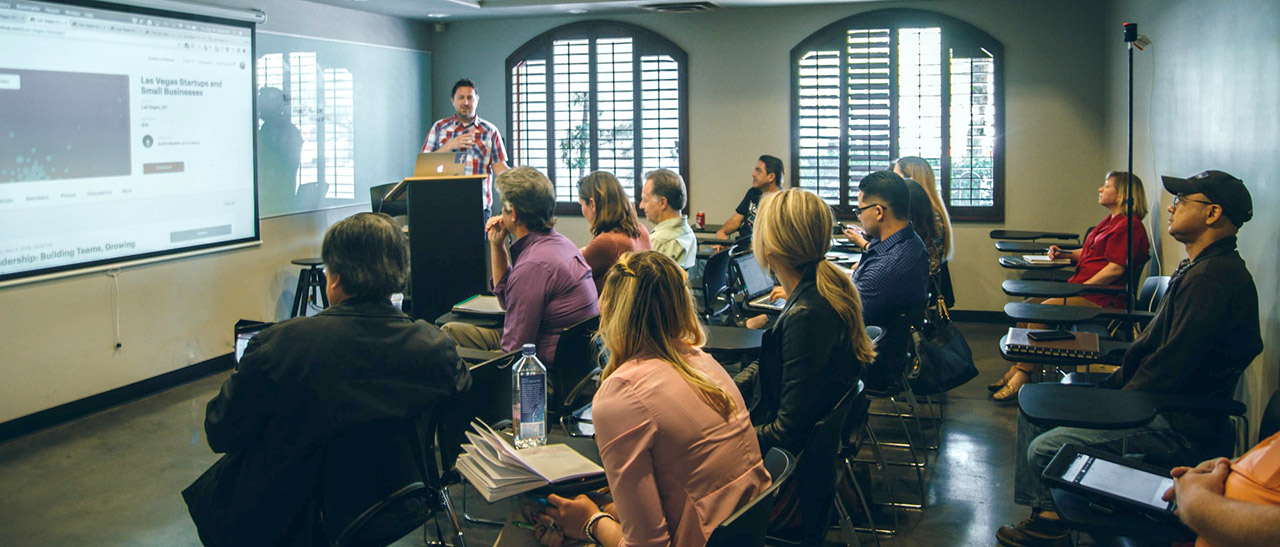Richard E. Mayer (2002): Cognitive Theory and the Design of Multimedia Instruction: An Example of the Two-Way Street Between Cognition and Instruction
The multimedia-based approach uses visual learning (pictures, written text, animations, and videos) and verbal learning (spoken narration) as discrete channels for delivering content. This way to teach differs completely from the traditional frontal teaching (ex-cathedra teaching) and lectures. The former classroom practice of lecturing to students or having students read silently is not the current state of the art. Multimedia learning can be delivered by a teacher but is often delivered by a computer running a software application or tools. In many cases, this tool is a web browser accessing a learning platform. The DISK project team used this concept in the development of the learning units.

Image: Typical frontal Lesson (lecturing ex-cathedra): Technology is used for the presentation, the learners are „passive consumers of content“. Source: UnSplash.com
What does multimedia really mean?
If you search for the term multimedia in a dictionary, you will find „the interaction and/or application of various media (texts, images, computer animations, graphics, music, sound, simulations) through the use of computers).
This short video gives you an instant overview to multimedia elements.
Why was multimedia-based and interactive content a cornerstone in the DISK course modules?
It has been known for 20 years that the use of multimedia learning materials improves the learning process and, above all, the learning outcomes[2]. The multimedia presentation of learning material provides a good framework for self-directed and individual learning. At the same time, the self-direction and individualization of learning through multimedia and interactive elements place new demands on the characteristics of the learners. The results show that many components must be interlocked in order to achieve effective learning processes and learning outcomes. Teaching and learning processes need to be considered in a multidimensional way. Clear differences in learning success can be demonstrated, especially in the areas of motivation, emotions, and cognitive characteristics.

Image: Learning with multimedia content makes fun and cares for better learning outcomes. Nevertheless – there are some issues to consider!
The challenge to implement multimedia-based learning content
With 20 years of knowledge about modern and efficient learning methods, the question arises why this kind of content has not found its way into the course curriculum for a longer time. It is important to note that changes have taken place in various fields of education, such as vocational education and training or school education. In adult education, this progress exists only to a small extent. Here are some ideas from the project team explaining the reasons of the mentioned issues and how you can change them.
- Trainer
In adult education, in particular, there are trainers with excellent technical qualifications, but who have a backlog in methods. One example is language courses: often native speakers hold these courses. Nevertheless, they do not have profound pedagogical training often.
Room for improvement: Personal professional training and further education in the pedagogical (and technological) field. - Technology
Many trainers have too few digital skills to either create materials or support learners in working with multimedia content.
Room for improvement: Personal professional training and further education in the field of technology and multiple devices[3]. - Multimedia-based Learning Content
Twenty years ago, the necessary software products were not available or too expensive.
Simultaneously, numerous – often web-based tools – are available for free with affordable fees.
Remark: The ⇒ Erasmus+ InterMedia project analyses these software tools and offers numerous examples for each of these tools. - Learners
The pilot training in the frame of the DISK project showed the need to explain and familiarise learners with the use of multimedia and interactive learning content. This involves both understandings how and why to work with this content and providing technical support.
Note: In adult education, you will often find people who, due to their age, have only experienced frontal teaching in school and first have to change to independent learning (this requires a change of mindset).
Similarly, the problem is that these older adults have too few digital skills and thus do not master electronic devices sufficiently. In these cases, we recommend introductory training (before the course) with the teaching of essential techniques.
[1] Richard E. Mayer (2002): Cognitive Theory and the Design of Multimedia Instruction: An Example of the Two-Way Street Between Cognition and Instruction
[2] Pala-Güngör, Sevda (2004): Multimediale Lernprozesse und Lernereigenschaften.
[3] The term „Multiple Devices“ was created by Carlos Guerrero (Head of VET education at SAFA, Seville) and Peter Mazohl (Head of the EFQBL) in 2017. Multiple devices describe the entirety of all devices suitable and used for displaying multimedia content. These are desktop PCs, laptops, notebooks, Chromebooks, convertibles, tablets, and finally smartphones. A study about the use of multiple devices is available from the Erasmus+ Project InterMedia.
